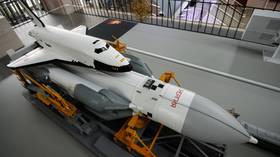‘Reshaping space market’: Russia mulls building rocket plane with nuclear engine

Russian space agency Roscosmos is considering building a spaceplane powered by a nuclear reactor, according to a memo obtained by a Russian news agency. The move could “reshape” the market for space launches, the document says.
A rocket plane is an aircraft powered by rocket engines. Conventional jets proved better for atmosphere-only flight, but this type of vehicle found its niche application as a reusable spacecraft – most notably as the Space Shuttle program.
Several rocket planes are still operational today, like the SpaceShipTwo, which is meant for suborbital tourist flights. Roscosmos believes such an aircraft may be viable for space missions if equipped with a nuclear power plant, says a memo reviewed by RIA Novosti.
The planning for future development of reusable space system must include considering novel designs like rocket planes with a nuclear-powered engine. Such systems may reshape the market for space launches in the future and create new niches.
The memo says Russia’s experience with creating the Buran spaceplane and similar space systems would come in handy for designing such a craft in the future.
Nuclear power is tricky to use in space, let alone harnessing it to provide propulsion. The USSR experimented with placing small nuclear reactors on its satellites for endurance, but the incident with the Kosmos 954 sat, which malfunctioned and fell in Canada in 1977, showed that potential problems probably outweigh the benefits. Improvements in solar panels made them the to-go power source in space applications while chemical and compressed gas thrusters are used for propulsion.
The picture may be different for long-range space missions, in which a reliable power source, capable of providing propulsion for months rather than minutes would be a huge advantage. Russia is currently working on a project dubbed TEM, a nuclear-powered rocket powered by a megawatt-class nuclear reactor.
Also on rt.com Russia ‘tests’ key piece of nuclear space engine to revolutionize long-range missionsRT’s military expert Mikhail Khodarenok says the vague wording of the memo indicates that Roscosmos is far from taking a decision to build a nuclear-propelled spaceplane.
Working on immediate problems like finishing the Vostochny cosmodrome or coping with competition from private space launch companies like Spacex is a greater priority for the Russian space agency, he believes.
Like this story? Share it with a friend!














